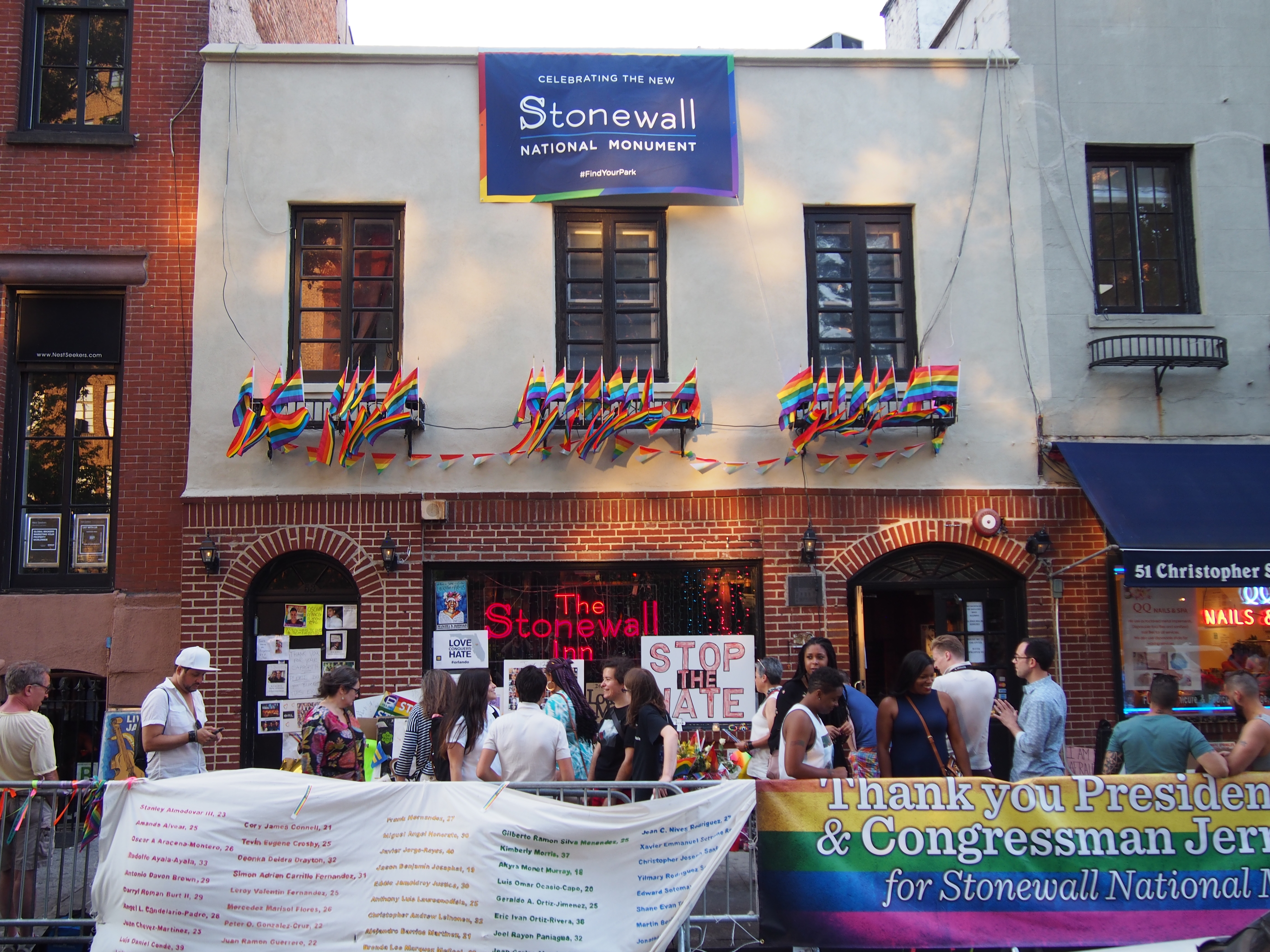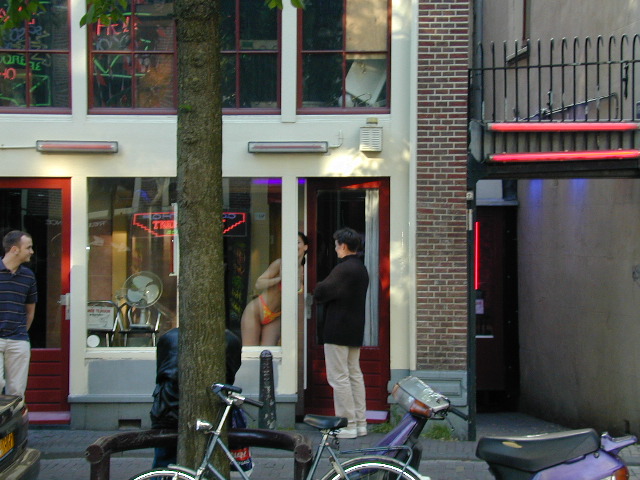|
Shinjuku Ni-chōme
Shinjuku Ni-chōme (新宿二丁目), referred to colloquially as Ni-chōme or simply Nichō, is Area 2 in the Shinjuku District of the Shinjuku Special Ward of Tokyo, Japan. With Tokyo home to 13 million people, and Shinjuku known as the noisiest and most crowded of its 23 special wards, Ni-chōme further distinguishes itself as Tokyo's hub of gay subculture, housing the world's highest concentration of gay bars. Within close walking distance from three train stations (Shinjuku San-chōme Station, Shinjuku Gyoenmae Station, and Japan's busiest train station, Shinjuku Station), the Shinjuku Ni-chōme neighborhood provides a specialized blend of bars, restaurants, cafes, saunas, love hotels, gay pride boutiques, cruising boxes ( hattenba), host clubs, nightclubs, massage parlors, parks, and gay book and video stores. In fact, within the five blocks centering on street Naka-Dōri between the BYGS building at the Shinjuku San-chōme Station and the small Shinjuku park three bloc ... [...More Info...] [...Related Items...] OR: [Wikipedia] [Google] [Baidu] |
Japan Times
''The Japan Times'' is Japan's largest and oldest English-language daily newspaper. It is published by , a subsidiary of News2u Holdings, Inc. It is headquartered in the in Kioicho, Chiyoda, Tokyo. History ''The Japan Times'' was launched by on 22 March 1897, with the goal of giving Japanese people an opportunity to read and discuss news and current events in English language, English to help Japan participate in the international community. In 1906, Zumoto was asked by Japanese Resident-General of Korea Itō Hirobumi to lead the English-language newspaper ''The Seoul Press''. Zumoto closely tied the operations of the two newspapers, with subscriptions of ''The Seoul Press'' being sold in Japan by ''The Japan Times'', and vice versa for Korea. Both papers wrote critically of Korean culture and civilization, and advocated for Korea under Japanese rule, Japan's colonial control over the peninsula in order to civilize the Koreans. The newspaper was independent of government ... [...More Info...] [...Related Items...] OR: [Wikipedia] [Google] [Baidu] |
Businesses Affecting Public Morals Regulation Act
The , also known as or , is a law that regulates entertainment places in Japan. History * 1948: Creation of the law. * April 1, 1959: Name change. * August 14, 1984: Extension to some businesses before midnight. * April 1998: Extension to some massage businesses and adult videos transmission by Internet. * November 2005: Penal regulation enforcement, various new rules. * January 2015: Proposition to relax the law is rejected. *Effective 2016 the law will be relaxed, allowing permits for exceptions as long as certain conditions are met including lighting and not operating near residential areas. Targets Businesses offering food and entertainment * Category 1: Japanese cabaret. * Category 2: Kyabakura (hostess bar). * Category 3: Business where customers can eat and dance. * Category 4: Dance hall. ** At first this covered dance schools too. Dance schools were removed from this category in 1998 after the movie Shall We Dance? made ballroom dance popular. * Category 5: Ba ... [...More Info...] [...Related Items...] OR: [Wikipedia] [Google] [Baidu] |
Tokyo Metro Fukutoshin Line
The , formally the , is a subway line operated by Tokyo Metro in west-central Tokyo and Wako, Saitama, Japan. The newest line in the Tokyo subway network, it opened in stages between 1994 and 2008. On average, the Fukutoshin Line carried 362,654 passengers daily in 2017, the lowest of all Tokyo Metro lines and roughly one third of its sister Tokyo Metro Yūrakuchō Line (1,124,478). Overview The Fukutoshin Line is the deepest metro line in Tokyo, with an average depth of . At Shinjuku-sanchōme Station, the line passes under the Tokyo Metro Marunouchi Line, Marunouchi and above the Toei Shinjuku Line, Shinjuku lines at a depth of , with a gap of only to the Shinjuku Line tunnel. The deepest section is at the immediately adjacent Higashi-Shinjuku Station, where the line goes down to , partly due to an underground space reservation for a possible future extension of the Jōetsu Shinkansen to Shinjuku. It is the second Tokyo Metro line to feature express services, after the Tokyo ... [...More Info...] [...Related Items...] OR: [Wikipedia] [Google] [Baidu] |
The Japan Times
''The Japan Times'' is Japan's largest and oldest English-language daily newspaper. It is published by , a subsidiary of News2u Holdings, Inc. It is headquartered in the in Kioicho, Chiyoda, Tokyo. History ''The Japan Times'' was launched by on 22 March 1897, with the goal of giving Japanese people an opportunity to read and discuss news and current events in English to help Japan participate in the international community. In 1906, Zumoto was asked by Japanese Resident-General of Korea Itō Hirobumi to lead the English-language newspaper '' The Seoul Press''. Zumoto closely tied the operations of the two newspapers, with subscriptions of ''The Seoul Press'' being sold in Japan by ''The Japan Times'', and vice versa for Korea. Both papers wrote critically of Korean culture and civilization, and advocated for Japan's colonial control over the peninsula in order to civilize the Koreans. The newspaper was independent of government control, but from 1931 onward, the pa ... [...More Info...] [...Related Items...] OR: [Wikipedia] [Google] [Baidu] |
LGBT
LGBTQ people are individuals who are lesbian, gay, bisexual, transgender, queer, or questioning. Many variants of the initialism are used; LGBTQIA+ people incorporates intersex, asexual, aromantic, agender, and other individuals. The group is generally conceived as broadly encompassing all individuals who are part of a sexual or gender minority, including all sexual orientations, romantic orientations, gender identities, and sex characteristics that are not heterosexual, heteroromantic, cisgender, or endosex, respectively. Scope and terminology A broad array of sexual and gender minority identities are usually included in who is considered LGBTQ. The term ''gender, sexual, and romantic minorities'' is sometimes used as an alternative umbrella term for this group. Groups that make up the larger group of LGBTQ people include: * People with a sexual orientation that is non-heterosexual, including lesbians, gay men, bisexual people, and asexual people * People ... [...More Info...] [...Related Items...] OR: [Wikipedia] [Google] [Baidu] |
Gay Pride Parade
A pride parade (also known as pride event, pride festival, pride march, or pride protest) is an event celebrating lesbian, gay, bisexual, transgender and queer (LGBTQ) social and self-acceptance, achievements, legal rights, and pride. The events sometimes also serve as demonstrations for legal rights such as same-sex marriage. Most occur annually throughout the Western world, while some take place every June to commemorate the 1969 Stonewall riots in New York City, which was a pivotal moment in modern LGBTQ social movements. The parades seek to create community and honor the history of the movement. In 1970, pride and protest marches were held in Chicago, New York City, Los Angeles, and San Francisco around the first anniversary of Stonewall. The events became annual and grew internationally. In 2019, New York and the world celebrated the largest international Pride celebration in history: Stonewall 50 - WorldPride NYC 2019, commemorating the 50th anniversary of the Stonewall ... [...More Info...] [...Related Items...] OR: [Wikipedia] [Google] [Baidu] |
Prostitution In Japan
Prostitution in Japan has existed throughout the country's history. While the Prostitution Prevention Law of 1956 states that "No person may either do prostitution or become the customer of it", loopholes, liberal interpretations and a loose enforcement of the law have allowed the Japanese sex industry to prosper and earn an estimated 2.3 trillion yen ($24 billion) per year. Sex trade and sex services may be referred to as , which also means "manners", "customs" or "public morals". Since Japanese law defines prostitution as "intercourse with an unspecified person in exchange for payment", most services offer specifically non-coital services, such as conversation, dancing or bathing, sometimes accompanied by sexual acts that legally are not defined as "intercourse", in order to remain legal. History From the 15th century, Chinese, Koreans, and other East Asian visitors frequented brothels in Japan. This practice later continued among visitors from "the Western regions", ... [...More Info...] [...Related Items...] OR: [Wikipedia] [Google] [Baidu] |
Diet Of Japan
, transcription_name = ''Kokkai'' , legislature = 215th Session of the National Diet , coa_pic = Flag of Japan.svg , house_type = Bicameral , houses = , foundation=29 November 1890(), leader1_type = President of the House of Councillors , leader1 = Masakazu Sekiguchi , party1 = LDP , election1 = 11 November 2024 , leader2_type = Speaker of the House of Representatives , leader2 = Fukushiro Nukaga , party2 = LDP , election2 = 11 November 2024 , leader3_type = Prime Minister , leader3 = Shigeru Ishiba , party3 = LDP , election3 = 1 October 2024 , members = , house1 = House of Councillors , structure1 = Japan House of Councillors Political Groups - November 2024.svg , political_groups1 = Government (140) * LDP (113) * Kōmeitō (27) Opposition (91) * CDP- SDP (41) * ... [...More Info...] [...Related Items...] OR: [Wikipedia] [Google] [Baidu] |
Constitution Of Japan
The Constitution of Japan is the supreme law of Japan. Written primarily by American civilian officials during the occupation of Japan after World War II, it was adopted on 3 November 1946 and came into effect on 3 May 1947, succeeding the Meiji Constitution of 1889. The constitution consists of a preamble and 103 articles grouped into 11 chapters. It is based on the principles of popular sovereignty, with the Emperor of Japan as the symbol of the state; pacifism and the renunciation of war; and Individual and group rights, individual rights. Upon the surrender of Japan at the end of the war in 1945, Japan was occupied and U.S. General Douglas MacArthur, the Supreme Commander for the Allied Powers, directed Prime Minister Kijūrō Shidehara to draft a new constitution. Shidehara created a committee of Japanese scholars for the task, but MacArthur reversed course in February 1946 and presented a draft created under his own supervision, which was reviewed and modified by the schol ... [...More Info...] [...Related Items...] OR: [Wikipedia] [Google] [Baidu] |
Sex Worker
A sex worker is a person who provides sex work, either on a regular or occasional basis. The term is used in reference to those who work in all areas of the sex industry.Oxford English Dictionary, "sex worker" According to one view, sex work is voluntary "and is seen as the commercial exchange of sex for money or goods". Thus it differs from sexual exploitation, or the forcing of a person to commit sexual acts. Terminology The term "sex worker" was coined in 1978 by sex worker activist Carol Leigh. Its use became popularized after publication of the anthology, ''Sex Work: Writings By Women In The Sex Industry'' in 1987, edited by Frédérique Delacoste and Priscilla Alexander. The term "sex worker" has since spread into much wider use, including in academic publications, by NGOs and labor unions, and by governmental and intergovernmental agencies, such as the World Health Organization. The term is listed in the Oxford English Dictionary and Merriam-Webster's Dictionary. The ... [...More Info...] [...Related Items...] OR: [Wikipedia] [Google] [Baidu] |
Akasen
was the Japanese slang term for districts historically engaged in the sex work industry in Japan, specifically within the time period of January 1946 through to March 1958. Etymology The term literally translates as "red-line". Though similar to another term previously used for red-light districts, , was used as a collective term for red-light districts only between 1946 and 1958, following an issue ordered by GHQ (SCAPIN 642) nationwide to abolish Japan's legalised system of sex work. Another term, , was used for "non-permitted" or "non-legal" sex industry districts. In Tokyo, the area directly across the Sumida river from Yoshiwara (Tamanoi, now called Higashi Mukōjima) was a well-known district; it features in some of Kafū Nagai's short stories. The term is often compared directly with the term "red-light district" in the west. However, this does not explain why the counterpart "non-permitted districts" were known as (blue-line) districts. In practice, and referr ... [...More Info...] [...Related Items...] OR: [Wikipedia] [Google] [Baidu] |








